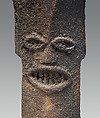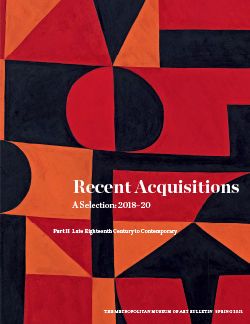Altar Figure
Not on view
This highly unusual work is the striking creation of an artist active in the region of the Nigeria/Cameroon border. The original treatment of the base as a hollow cylinder enhanced with the depiction of two visages facing in opposite directions has led for the sculpture to be misinterpreted as a helmet mask. It has been reattributed as an altar sculpture, a form found in the Kaka region. The contrasting carving of the figure positioned at the top of the cylindrical base, is also highly distinctive: the combination of its wing-like arms facing in two directions as well as the horned coiffure are particularly inspired and contribute to the sculpture's dynamism. Finally, its thick, crusty patina made of soot and oils, as well as the perceivable dichromic surface firmly position it as the creation of a Kaka artist, possibly inspired by works created by artists active in the Bangwa chiefdom of the neighboring Cameroon Grassfields. Repeated confusion in scholarship between art created by Kaka artists in Cameroon, and Keaka artists on the Nigerian side of the Cross River, render interpretation difficult.
Due to rights restrictions, this image cannot be enlarged, viewed at full screen, or downloaded.
This artwork is meant to be viewed from right to left. Scroll left to view more.







